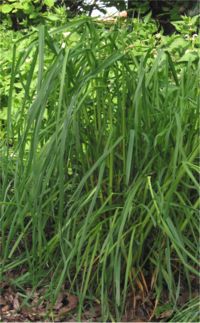Dactylis glomerata: Difference between revisions
template |
m moved Dactylis to Dactylis glomerata: usually treated as only species per WP |
||
| (2 intermediate revisions by 2 users not shown) | |||
| Line 1: | Line 1: | ||
__NOTOC__{{Plantbox | __NOTOC__{{Plantbox | ||
| name = ''Dactylis'' | | name = ''Dactylis glomerata'' | ||
| common_names = <!--- if multiple, list all, if none, leave blank --> | | common_names = <!--- if multiple, list all, if none, leave blank --> | ||
| growth_habit = <!--- tree, shrub, herbaceous, vine, etc --> | | growth_habit = <!--- tree, shrub, herbaceous, vine, etc --> | ||
| Line 27: | Line 27: | ||
|genus = Dactylis | |genus = Dactylis | ||
|species = glomerata | |species = glomerata | ||
| species = | | species = glomerata | ||
| subspecies = | | subspecies = | ||
| cultivar = | | cultivar = | ||
}} | }} | ||
'''''Dactylis glomerata''''' ('''Cocksfoot''' or '''Orchard Grass''' or '''Cocksfoot Grass''') is a common [[Poaceae|grass]], native to . | '''''Dactylis glomerata''''' ('''Cocksfoot''' or '''Orchard Grass''' or '''Cocksfoot Grass''') is a common [[Poaceae|grass]], native to . | ||
It is usually treated as the sole species in the genus '''''Dactylis''''', but is commonly divided into several regional [[subspecies]]; some [[botanist]]s treat some of these as distinct species, or at the lower rank of [[variety (biology)|variety]]. | It is usually treated as the sole species in the genus '''''Dactylis''''', but is commonly divided into several regional [[subspecies]]; some [[botanist]]s treat some of these as distinct species, or at the lower rank of [[variety (biology)|variety]]. | ||
{{Inc| | |||
Dactylis (Greek daktulos, a finger). Gramineae. A perennial tufted grass with flat blades, thin prominent ligules and sheaths closed nearly to the throat, grown for forage and one form for ornament. | |||
Panicles glomerate; spikelets 2-5-fld., nearly sessile in dense 1-sided fascicles, these arranged in a panicle; lemmas hispid-ciliate on the keels, awn-tipped, compressed.—Species 1, north temperate regions of the Old World. | |||
Dactylis glomerata, Linn. Orchard-grass. Fig. 1203. A coarse grass. 2-3 ft., forming large tussocks: panicle a few stiff branches, expanding in fl., afterwards appressed.—Commonly cult, as a pasture and meadow grass and useful for lawns under trees. Var. variegata, Hort., is a dwarf form of compact habit with foliage variegated silver and green; used for borders. Prop, by division; of easy cultivation. | |||
{{SCH}} | |||
}} | |||
==Cultivation== | ==Cultivation== | ||
{{edit-cult}}<!--- Type cultivation info below this line, then delete this entire line --> | {{edit-cult}}<!--- Type cultivation info below this line, then delete this entire line --> | ||
| Line 86: | Line 77: | ||
==References== | ==References== | ||
*[[Standard Cyclopedia of Horticulture]], by L. H. Bailey, MacMillan Co., 1963 | |||
<!--- xxxxx *Flora: The Gardener's Bible, by Sean Hogan. Global Book Publishing, 2003. ISBN 0881925381 --> | <!--- xxxxx *Flora: The Gardener's Bible, by Sean Hogan. Global Book Publishing, 2003. ISBN 0881925381 --> | ||
<!--- xxxxx *American Horticultural Society: A-Z Encyclopedia of Garden Plants, by Christopher Brickell, Judith D. Zuk. 1996. ISBN 0789419432 --> | <!--- xxxxx *American Horticultural Society: A-Z Encyclopedia of Garden Plants, by Christopher Brickell, Judith D. Zuk. 1996. ISBN 0789419432 --> | ||
Latest revision as of 04:04, 26 August 2009
Dactylis glomerata {{{latin_name}}}
|
'
| ||||||||||||||||||||||||||||||||||||||||
|---|---|---|---|---|---|---|---|---|---|---|---|---|---|---|---|---|---|---|---|---|---|---|---|---|---|---|---|---|---|---|---|---|---|---|---|---|---|---|---|---|---|

|
|
| |||||||||||||||||||||||||||||||||||||||
| |||||||||||||||||||||||||||||||||||||||||
Dactylis glomerata (Cocksfoot or Orchard Grass or Cocksfoot Grass) is a common grass, native to .
It is usually treated as the sole species in the genus Dactylis, but is commonly divided into several regional subspecies; some botanists treat some of these as distinct species, or at the lower rank of variety.
| Standard Cyclopedia of Horticulture |
|---|
|
Dactylis (Greek daktulos, a finger). Gramineae. A perennial tufted grass with flat blades, thin prominent ligules and sheaths closed nearly to the throat, grown for forage and one form for ornament. Panicles glomerate; spikelets 2-5-fld., nearly sessile in dense 1-sided fascicles, these arranged in a panicle; lemmas hispid-ciliate on the keels, awn-tipped, compressed.—Species 1, north temperate regions of the Old World. Dactylis glomerata, Linn. Orchard-grass. Fig. 1203. A coarse grass. 2-3 ft., forming large tussocks: panicle a few stiff branches, expanding in fl., afterwards appressed.—Commonly cult, as a pasture and meadow grass and useful for lawns under trees. Var. variegata, Hort., is a dwarf form of compact habit with foliage variegated silver and green; used for borders. Prop, by division; of easy cultivation. CH
|
Cultivation
- Do you have cultivation info on this plant? Edit this section!
Propagation
- Do you have propagation info on this plant? Edit this section!
Pests and diseases
- Do you have pest and disease info on this plant? Edit this section!
Subspecies
- Dactylis glomerata subsp. glomerata
- Dactylis glomerata subsp. himalayensis
- Dactylis glomerata subsp. hispanica (syn. D. hispanica)
- Dactylis glomerata subsp. ibizensis
- Dactylis glomerata subsp. judaica
- Dactylis glomerata subsp. juncinella
- Dactylis glomerata subsp. lobata (syn. D. aschersoniana)
- Dactylis glomerata subsp. lusitanica
- Dactylis glomerata subsp. marina (syn. D. marina)
- Dactylis glomerata subsp. santai
- Dactylis glomerata subsp. smithii
- Dactylis glomerata subsp. woronowii (syn. D. woronowii)
Gallery
If you have a photo of this plant, please upload it! Plus, there may be other photos available for you to add.
-
photo 1
-
photo 2
-
photo 3
References
- Standard Cyclopedia of Horticulture, by L. H. Bailey, MacMillan Co., 1963
External links
- w:Dactylis glomerata. Some of the material on this page may be from Wikipedia, under the Creative Commons license.
- Dactylis glomerata QR Code (Size 50, 100, 200, 500)
